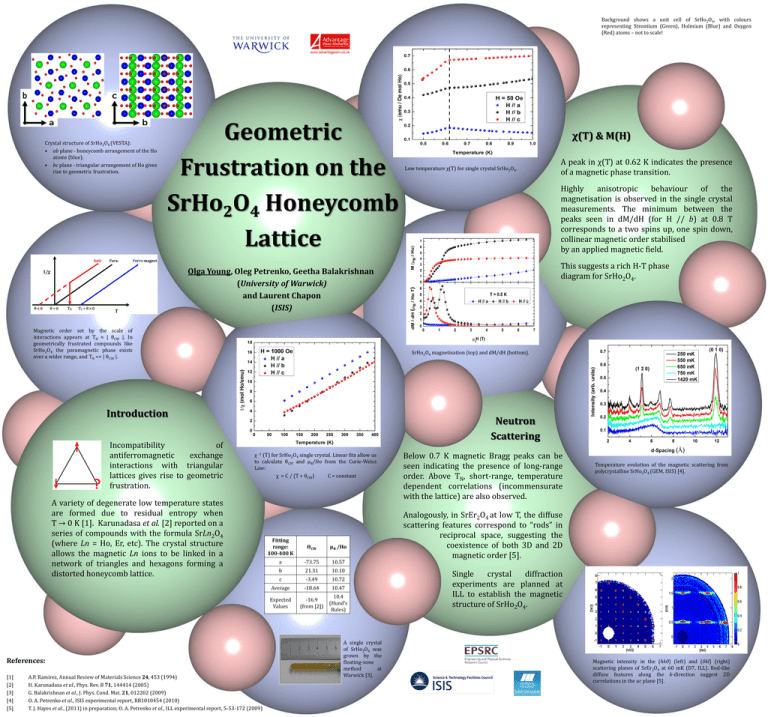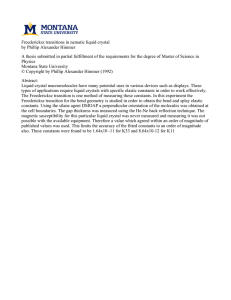Geometric Frustration on the χ(T) & M(H)
advertisement

Background shows a unit cell of SrHo2O4, with colours representing Strontium (Green), Holmium (Blue) and Oxygen (Red) atoms – not to scale! Crystal structure of SrHo2O4 (VESTA): • ab plane - honeycomb arrangement of the Ho atoms (blue). • bc plane - triangular arrangement of Ho gives rise to geometric frustration. Geometric Frustration on the SrHo2O4 Honeycomb Lattice χ(T) & M(H) Low temperature χ(T) for single crystal SrHo2O4. Highly anisotropic behaviour of the magnetisation is observed in the single crystal measurements. The minimum between the peaks seen in dM/dH (for H // b) at 0.8 T corresponds to a two spins up, one spin down, collinear magnetic order stabilised by an applied magnetic field. This suggests a rich H-T phase diagram for SrHo2O4. Olga Young, Oleg Petrenko, Geetha Balakrishnan (University of Warwick) and Laurent Chapon (ISIS) Magnetic order set by the scale of interactions appears at TN ≈ | θCW |. In geometrically frustrated compounds like SrHo2O4 the paramagnetic phase exists over a wider range, and TN << | θCW |. SrHo2O4 magnetisation (top) and dM/dH (bottom). Introduction Incompatibility of antiferromagnetic exchange interactions with triangular lattices gives rise to geometric frustration. Neutron Scattering χ -1 (T) for SrHo2O4 single crystal. Linear fits allow us to calculate θCW and μB/Ho from the Curie-Weiss Law: χ = C / (T + θCW) C = constant A variety of degenerate low temperature states are formed due to residual entropy when T → 0 K [1]. Karunadasa et al. [2] reported on a series of compounds with the formula SrLn2O4 (where Ln = Ho, Er, etc). The crystal structure allows the magnetic Ln ions to be linked in a network of triangles and hexagons forming a distorted honeycomb lattice. References: [1] [2] [3] [4] [5] A peak in χ(T) at 0.62 K indicates the presence of a magnetic phase transition. A.P. Ramirez, Annual Review of Materials Science 24, 453 (1994) H. Karunadasa et al., Phys. Rev. B 71, 144414 (2005) G. Balakrishnan et al., J. Phys. Cond. Mat. 21, 012202 (2009) O. A. Petrenko et al., ISIS experimental report, RB1010454 (2010) T. J. Hayes et al., (2011) in preparation; O. A. Petrenko et al., ILL experimental report, 5-53-172 (2009) Fitting range: 100-400 K ϴCW μB /Ho a -73.75 10.57 b 21.31 10.10 c -3.49 10.72 Average -18.64 10.47 Expected Values -16.9 (from [2]) 10.4 (Hund’s Rules) A single crystal of SrHo2O4 was grown by the floating-zone method at Warwick [3]. Below 0.7 K magnetic Bragg peaks can be seen indicating the presence of long-range order. Above TN, short-range, temperature dependent correlations (incommensurate with the lattice) are also observed. Temperature evolution of the magnetic scattering from polycrystalline SrHo2O4 (GEM, ISIS) [4]. Analogously, in SrEr2O4 at low T, the diffuse scattering features correspond to “rods” in reciprocal space, suggesting the coexistence of both 3D and 2D magnetic order [5]. Single crystal diffraction experiments are planned at ILL to establish the magnetic structure of SrHo2O4. Magnetic intensity in the (hk0) (left) and (0kl) (right) scattering planes of SrEr2O4 at 60 mK (D7, ILL). Rod-like diffuse features along the k-direction suggest 2D correlations in the ac plane [5].



